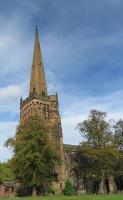
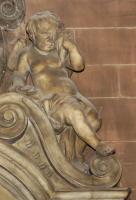
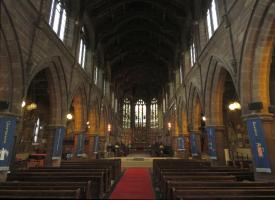
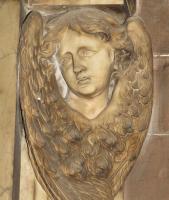
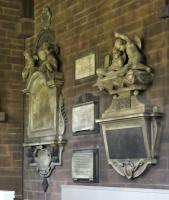
Sculpture of the month for November consists of two works by the great sculptor John Michael Rysbrach in Aston Parish Church, Birmingham. They are monumental tablets, firstly to Sir John and Lady Bridgeman, made in 1726, and secondly to Robert and Letitia Holden and their daughter Catherine, carved in 1753. They thus date fairly early and fairly late in Rysbrack’s career as a sculptor.
Bridgeman and Holden monuments, by J.M. Rysbrack.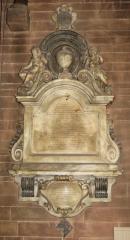
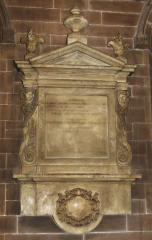
For those interested in sculpture in Britain, Rysbrack’s name crops up as one of the key figures in the first half of the 18th Century, above all for his grand portrait statues – Hans Sloane in the Chelsea Physick Garden, the ruined George II for Greenwich, a number of standing figures in Westminster Abbey, and the noble equestrian statue of William III in Queen Square, Bristol - see this page. The Westminster Abbey figures are by no means his only portrait statues for monuments, and there are a number of other grand figure pieces by Rysbrack in churches and cathedrals up and down the country.
The Aston panels represent another side of Rysbrack’s monumental art: one size less grand, consisting of wall panels, still highly carved and with lesser figure sculpture: thus a pair of cherubs in the Bridgeman monument, and winged angel heads in the Holden monument, along with cartouches and more minor carving. They have their own style too. What do we see? A Classical panel, certainly, the central inscribed panel being within a frame consisting of pilasters (flat pillars) at the sides, supporting a pediment – an open one in the case of the Holden monument – with sculptural decoration sitting on top of this in the centre and at the sides. At the base is a shelf, of similar mass to the upper pediment, and then underneath is the ‘apron’, a lower base of stone with some adornment upon it.
The level of decoration is typical for the time: there are plenty of such panel monuments without major figure sculpture dating from the 17th Century, but the earlier ones tend to the flamboyant and Baroque or Rococo extravagance, with few sculptors resisting the temptation to include a bit of hanging drapery and at least a broken, curly pediment. By the 1780s, a cool, restrained sort of Classicism was in the ascendant, though the occasional flourish and carved cartouche survived right up into the 1800s. The Aston Rysbrack panels are fairly advanced along the intermediate path – we see the simple Classical forms emerging in the frames, but some measure of the Baroque survives in the small cartouches and the spiral scrolling, and the panache of the poses of cherubs and angel heads. Other panels in Aston Church show this path from the flamboyant (e.g. Diana Holte, d.1724 as a late example) through to severely Classical of the 1800s (e.g. James Goddington, d.1821, by William Hollins of Birmingham).
Rysbrack's cartouche for the Bridgeman panel.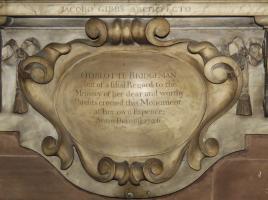
Back to our pair. Characteristic of Rysbrack in particular are the cartouches found at the base of each monument, a device he uses in a number of other works on this scale, and the general proportions of the panel frames, especially the Holden one, with essentially square central panel, and spirals at the base of each side.
The two angel heads in the Holden monument are essentially caryatids (see picture above, and close up at top of page), thus the heads support the ends of the shelf or capitals above: similar caryatids are used in Rysbrack’s panel to Sir Peter Delme, d.1740, in St Margaret Pattens in the City of London, for example – in both cases, the scrolling etc beneath the head is of the right size that we can half see a full standing figure there. (For lots of pictures of caryatids, see this page.)
The cherubs of the Bridgeman monument (see pictures below and top of page) are also a familiar Rysbrack feature – the Peter Delme monument has a pair, there is a similar single cherub in the Ogle Challoner monument in Twickenham (see this page), and in Mitcham is a likely work by Rysbrack with two more similar cherubs (see this page). Rysbrack cherubs are like Rysbrack statues – they have a certain swagger in their pose, a superior class of cherub altogether. (If you like cherubs, see this page, or for winged cherub heads, see this page.)
We should note that the Bridgeman monument was designed by James Gibbs, the architect, at least in part, but the elements are all Rysbrack. Rysbrack worked for James Gibbs for some long period, under terms much more favourable to the architect than the sculptor, until he broke away to set up entirely on his own.
A few more words on Rysbrack himself – he was born in Antwerp in 1694, came to England as a young man in 1720, and stayed until 1763, thus spending almost all his working life in the country, working at a prodigious rate producing exceptionally good sculpture. Another low country sculptor, Peter Scheemakers, became his great rival, and between these two and the French Louis-Francois Roubiliac, many of the most important monuments in the first half of the 18th Century were conceived. More on Rysbrack on this page.
Aston Parish Church – St Peter and St Paul (pictures of exterior and interior view at top of page) – is a very special church in terms of its monuments, with the greatest treasures being the series of 10 grand medieval effigies, a number and of a quality rivalled only by the greatest cathedrals and abbeys in the land.
Back to October Sculpture of the Month // Onward to December
Aston Parish Church // J.M. Rysbrack
Other Birmingham sculpture // Sculpture in England // Sculpture pages
Visits to this page from 1 Nov 2017: 3,383